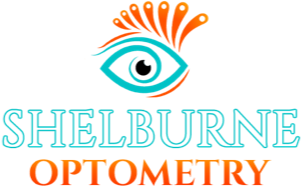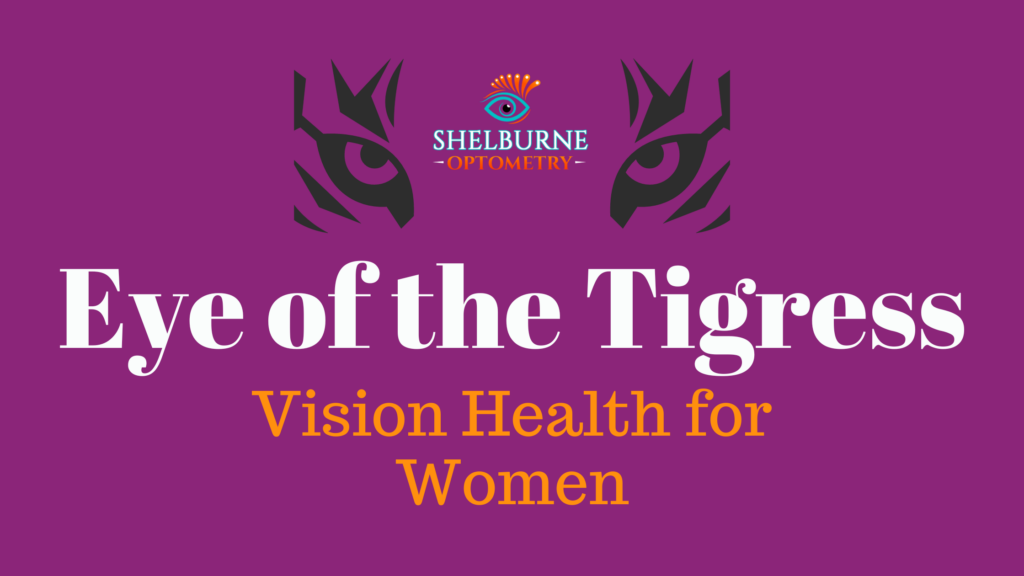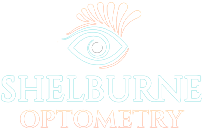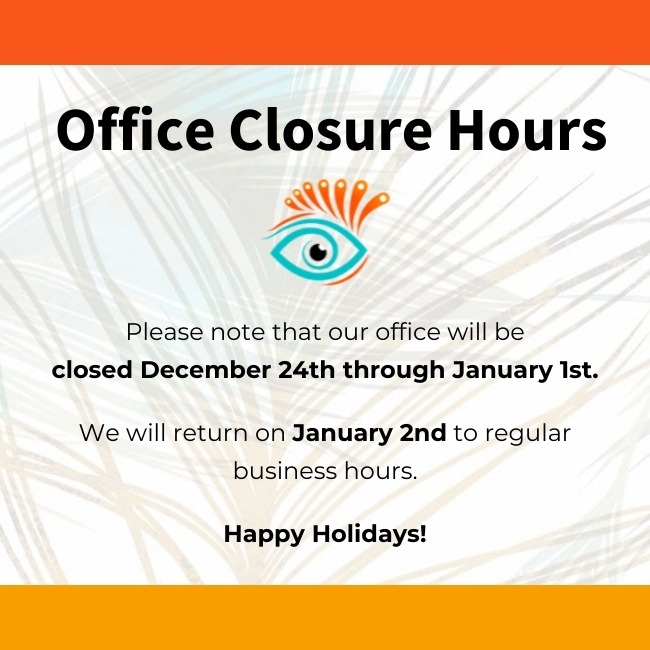April is Women’s Eye Health & Safety Month, designated by the non-profit group Prevent Blindness to raise awareness and offer education on the differences women face when it comes to their vision.
This blog post discusses eye disease, pregnancy and menopause as they affect the vision of AFAB (assigned female at birth) individuals, due to specific hormonal details that differ from AMAB (assigned male at birth) individuals. The discussion of contact lenses and makeup is totally universal, dears.

Eye Disease
You may not realise it, but many eye diseases affect women more often than men. According to studies, as many as two out of every three adult individuals living with vision problems (including refractive error and blindness) are women. Eye diseases that are seen more often in women include: Age-Related Macular Degeneration, Cataracts, Glaucoma, and Thyroid Eye Disease. Women are also more prone to Dry Eye Disease (which can be linked to rosacea, Premature Ovarian Insufficiency, Pregnancy, and Menopause), and Auto-Immune Disorders such as Sjögren’s Syndrome and Lupus (which I’ve learned has nothing at all to do with lycanthropy).
One answer to the regularity of these diseases in women is that we tend to live longer (muahaha), and are thus more likely to live to “see” age-related eye diseases, and are also more likely to undergo cancer treatments that may affect our vision.
The other answer, which is still deeply undergoing fascinating study, is hormones. Most of the tissues found in our wonderfully complex eyeballs are full of cell receptors that directly respond to the regulation of our hormones. It’s for this reason that doctors and professionals in the fields of biology and ophthalmology want to know more about the differences between female and male hormones and why they uniquely affect our vision.
Two experiences that directly affect the female body’s regularly scheduled hormone programming (and thus their vision) are pregnancy and menopause.
Pregnancy
It is extremely common to experience changes in vision during pregnancy. This is due to the fluctuation of oestrogen levels, which can lead to refractive changes (needing a different prescription to see clearly). In many cases vision returns to normal following delivery.
It’s important to note any changes in vision while pregnant. Simply because they’re common doesn’t mean there isn’t a chance something else is going on. Always keep up with regular eye exams during pregnancy, so the doctor can determine if the changes you’re experiencing are due solely to the pregnancy, or perhaps have roots elsewhere. Those already diagnosed with diabetes, high blood pressure and glaucoma should always inform their optometrist if they’re pregnant or trying for pregnancy, so the existing condition can be properly monitored. Gestational Diabetes is also a thing, experienced by women whose blood sugar levels rise during pregnancy.
Dry Eye is also very common during pregnancy, and tends to pass following delivery. Dry Eye treatment and management is easier than it’s ever been, and eye doctor approved preservative free eye drops are perfectly safe to use while awaiting the arrival of your tiny human.
Menopause
Similar to pregnancy, the fluctuating hormone levels experienced by women entering menopause can lead to changes in vision. Onset of blurred vision is often the most noticeable symptom. This blurriness commonly occurs due to the body’s decreasing oestrogen levels, which causes the cornea (the protective layers at the front of your eye) to stiffen, thus affecting how these layers refract light.
Dry Eye is also prevalent in women with menopause, because why not? This generally occurs due to the aforementioned corneas losing their elasticity. As if there isn’t enough going on with our bodies during this time, at the very least awareness gives us the power to know what to do when these changes come. Ensuring you’re getting enough omega-3 fatty acids, and regular use of warm compresses and proper ophthalmic drops (step away from the Visine) are all easy ways to make your vision transition more comfortable.
Contact Lenses
According to studies, contact lens wear is also more common among women than men. It’s estimated that in the USA, as many as two thirds of contact lens wearers identify as women. Now whether this is because we want interchangeable sunglass freedom, or a chance to look even more fierce than we already do with a rainbow of stunning eye colours, remains to be seen. Perhaps it’s simply convenient.
Regardless of why we wear them, frequent contact lens use means higher risk of Dry Eye Disease (as though we weren’t at risk enough), as well as bacterial infections due to unhygienic practices, and—so fun—corneal issues, such as corneal abrasions (due to a foreign object between the cornea and the lens, or a lens with a rough/torn edge) and even corneal ulcers (for the love of all you hold dear, do not sleep in your contact lenses).
Long story short, exercise responsibility and best hygiene practices when using contact lenses, and always have an optometrist fit you with the correct lenses for your unique eye shape to avoid the horrors listed above.

Makeup
Wearing makeup is a timeless form of self expression, allowing us the power to change our appearance at will, to present ourselves to the world in whatever vibe we’re feeling that day. But with great power comes great responsibility: while makeup is a fantastic tool to help us feel fabulous, it also requires diligent hygiene practices to ensure we stay healthy while keepin’ our peepers poppin’.
I’m sure you can guess by now that improper makeup usage can lead to those dreaded dry eyes, but what doesn’t occur to a lot of people is the risk of bacterial infection. Prolonged wear, unclean brushes, improper storage, and the general potential for ick caused by the environment and rubbing one’s eyes throughout the day can all lead to a bad trip to the optometrist.
Have you ever pulled out your mascara wand to find a random cat hair and thought, How on earth did that get in there? Our little bundles of joy are just walking fluffy auras, and their fur and dander get everywhere. Be sure to store your makeup away from curious paws, and regularly clean your tools with a proper brush cleaner to remove not only makeup, but dust and bacteria build-up.
And please, please please please, no matter how tempted, please, do not sleep in your makeup. Prolonged wear can clog your meibomian glands (responsible for delivering proper lubrication to your eyes), and rubbing your eyes in your sleep can carry product into your eye, which can cause not only infection, but in some cases even corneal abrasion. Cosmetics containing retinoids (such as Retinol and Retin-A derivatives) have been shown to increase your risk of dry eye disease and gland dysfunction.
Shop smart and take care to keep your ocular health in mind when indulging in makeup. Eye-safe cosmetics are always the best option and are rapidly growing in popularity. (I mention some in the next section!)
Best Practices for Your Vision Health
Taking your vision health journey into your own hands empowers you with the knowledge and tools needed to ensure you continue building memories you can see clearly.
Here’s how Shelburne Optometry can help:
Aura Eye Spa & Aesthetics – You absolutely read that correctly: Shelburne Optometry offers a wide range of medical aesthetic services, including rosacea and dry eye treatment, among others. You can schedule a complimentary skin consultation with our fabulous Medical Aesthetician here.
Dry Eye Clinic – We offer dry eye diagnosis and management, as well as in-office treatments, and a range of products to help you feel more comfortable as soon as possible. And not to brag, but our Dry Eye Treatment Coordinator is pretty awesome. You can schedule a Dry Eye Assessment with us here.
Cosmetics – We carry cosmetic lines in-store, Twenty Twenty Beauty and Eyes Are The Story, that are made of the best quality ingredients, with your vision health as well as beauty in mind, that are actually approved by ophthalmologists. In addition, we also have many skin care products that pair beautifully with our spa treatments, and our clinic is proud to be a part of the movement raising awareness on the relationship between eye care and skin care.
Contact Lens Fitting & Training – Contact Lenses are considered regulated medical devices in Ontario and require a specialised prescription. All of our eyes are uniquely shaped, and wearing the wrong contact lenses can lead to a plethora of problems. Our doctors will take the time to find the right lens for your needs, and first-time wearers can learn all the tricks from the best Contact Lens Specialist around. Call our office to discuss the best steps for you.
Optical Coherence Tomography (OCT Imaging) – Digital retinal imaging is a series of scans of the back of your eye that gives your doctor a 3D picture of what’s going on and allows for much earlier detection of many potential eye diseases. We highly recommend OCT Imaging at your regular eye exam, as it is the most comprehensive snapshot of your ocular health.
Visual Field Testing – Some of you may know this as the “light test”, and others may have heard us refer to it lovingly as the “world’s most boring video game”. In a nutshell, Visual Field Testing allows your optometrist to record the span and accuracy of your peripheral vision, which can offer hints related to certain eye conditions and diseases (such as glaucoma).

Final Thoughts
It’s clear that more research is needed to determine the specifics of why AFAB individuals are more susceptible to certain eye diseases than AMAB individuals, but the conversations are happening and the studies are underway. With more information, we’ll be able to create better preventative plans to ensure everyone can have as much control as possible over the health and development of their vision.
While the influences of hormones may be out of our hands, ocular hygiene is entirely in our control to ensure we’re taking care of our eyes while still presenting our fiercest self to the world. Smart choices like regular eye exams, wearing the correct contact lenses, and best hygiene practices allow us to experience this beautiful life seeing, looking and feeling spectacular.
The power is yours.
Wishing you all the best in wherever your path takes you today,
Sydney
